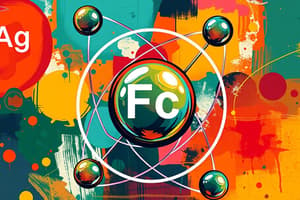Podcast
Questions and Answers
What is the difference between an atom and an ion?
What is the difference between an atom and an ion?
An atom contains a nucleus with an equal number of protons and electrons, while an ion has an unequal number of protons and electrons.
Define a molecule.
Define a molecule.
A molecule is formed when two or more atoms bond to create a stable structure.
What is an element?
What is an element?
An element is a substance made entirely of the same type of atoms.
What is a compound?
What is a compound?
What is a free radical?
What is a free radical?
Define metabolism.
Define metabolism.
What are the two types of metabolism?
What are the two types of metabolism?
What is ATP?
What is ATP?
What does cellular preference refer to?
What does cellular preference refer to?
Define cellular respiration.
Define cellular respiration.
What happens during aerobic cellular respiration?
What happens during aerobic cellular respiration?
What happens during anaerobic cellular respiration?
What happens during anaerobic cellular respiration?
Define pyruvic acid.
Define pyruvic acid.
What are nutrients?
What are nutrients?
Define organic compounds.
Define organic compounds.
Define inorganic compounds.
Define inorganic compounds.
What is dissociation?
What is dissociation?
What is an acid?
What is an acid?
What is a base?
What is a base?
What is a salt?
What is a salt?
What does the pH scale measure?
What does the pH scale measure?
Study Notes
Atoms vs Ions
- Atoms are the fundamental building blocks of matter, composed of a nucleus (containing protons and neutrons) and surrounding electrons.
- Ions are atoms with an imbalance in the number of protons and electrons.
Key Chemical Concepts
- Molecules: Two or more atoms bonded together, forming a stable structure.
- Element: A pure substance composed entirely of the same type of atom. Oxygen, hydrogen, carbon, and nitrogen constitute 96% of the body's mass.
- Compound: A substance formed by the combination of two or more different types of atoms. For example, water (H2O) is a compound made of hydrogen and oxygen.
- Free Radical: An atom or molecule with an unpaired electron, potentially damaging to cells.
Metabolism
- Metabolism: The sum of all chemical reactions occurring in the body.
- Anabolism: The building phase of metabolism; simpler molecules are combined to form more complex ones, requiring energy.
- Catabolism: The breakdown phase of metabolism; complex molecules are broken down into simpler ones, releasing energy. This includes the breakdown of food to generate ATP.
ATP
- ATP (Adenosine Triphosphate): The primary energy currency of cells, utilized for various functions like muscle contraction, cell division, and substance transport across cell membranes.
- Energy for ATP production is derived from breaking down food (catabolism).
Cellular Preference
- Different cells and activities require varying energy sources and quantities.
- During light activity, energy demand is lower, and carbohydrates are primarily used.
- During intense exercise, energy demand is higher and the body primarily utilizes fats.
Cellular Respiration
- Cellular Respiration: The process of extracting energy from food molecules.
- Aerobic Cellular Respiration: Occurs in the presence of oxygen. Example: Sitting and relaxing, oxygen uptake is sufficient for energy production.
- Anaerobic Cellular Respiration: Occurs without oxygen. Example: Intense exercise where oxygen supply is insufficient, leading to the build-up of lactic acid.
Energy Substrate Metabolism
- Carbohydrate (Glucose) Metabolism: The primary energy substrate, used quickly but in small amounts. It can be broken down with or without oxygen.
- Glycolysis: Breakdown of glucose.
- Glycogen: The stored form of glucose.
- Fat Metabolism: Requires oxygen for energy production, slower but generates more ATP.
- Lipolysis: Breakdown of stored fat.
- Triglycerides: Storage form of fat.
- Protein Metabolism: Least preferred, as amino acids are broken down and require more time and produce waste. Utilized when carbohydrate and fat reserves are low.
Pyruvic Acid
- Pyruvic Acid: A product of glucose breakdown, forming two molecules and two ATP.
- Aerobic Cellular Respiration: Pyruvic acid enters the mitochondria, producing more ATP.
- Anaerobic Cellular Respiration: Pyruvic acid is converted into Lactic Acid, then into lactate, which diffuses out of the cell and circulates in the blood. This is the commonly felt "burning" sensation during intense exercise.
Key Cellular Substances
- Nutrients: Substances necessary for body structure and function.
- Organic Compounds: Contain carbon. Include ATP, carbohydrates, fats, proteins, and nucleic acids.
- Inorganic Compounds: Do not contain carbon. Water accounts for 65% of body weight, alongside acids, bases, and salts.
Dissociation
- Dissociation: The process of separating inorganic acids, bases, and salts into ions in a solution.
Acids, Bases, and Salts
- Acid: Releases one or more hydrogen ions (H+) in solution.
- Base: Releases one or more hydroxide ions (OH-) in solution.
- Salt: Releases positive and negative ions, but not H+ or OH-.
pH Scale
- The pH scale measures the acidity or alkalinity (basicity) of a solution.
- A pH of 0 is the most acidic, while a pH of 14 is the most basic.
- Neutral substances have a pH of 7, like pure water.
Studying That Suits You
Use AI to generate personalized quizzes and flashcards to suit your learning preferences.
Related Documents
Description
Explore the differences between atoms and ions while learning key concepts in chemistry such as molecules, elements, compounds, and free radicals. Additionally, dive into the intricacies of metabolism, including anabolism and catabolism, to understand the chemical reactions that fuel life.




